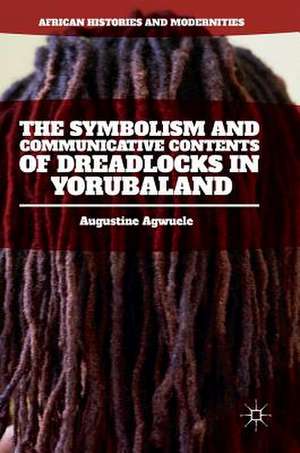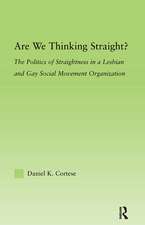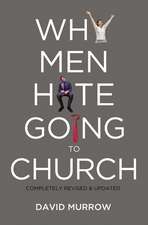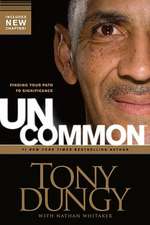The Symbolism and Communicative Contents of Dreadlocks in Yorubaland: African Histories and Modernities
Autor Augustine Agwueleen Limba Engleză Hardback – 22 aug 2016
This book offers an interpretation of Yoruba people’s affective responses to an adult Yoruba male with a ‘deviant’ hairstyle. The work, which views hairstyles as a form of symbolic communicative signal that encodes messages that are perceived and interpreted within a culture, provides an ontological and epistemological interpretation of Yoruba beliefs regarding dreadlocks with real-life illustrations of their treatment of an adult male with what they term irun were (insane person’s hairdo). Based on experiential observations as well as socio-cultural and linguistic analyses, the book explores the dynamism of Yoruba worldview regarding head-hair within contemporary belief systems and discusses some of the factors that assure its continuity. It concludes with a cross-cultural comparison of the perceptions of dreadlocks, especially between Nigerian Yoruba people an
d African American Yoruba practitioners.| Toate formatele și edițiile | Preț | Express |
|---|---|---|
| Paperback (1) | 381.81 lei 43-57 zile | |
| Springer International Publishing – 22 apr 2018 | 381.81 lei 43-57 zile | |
| Hardback (1) | 386.99 lei 43-57 zile | |
| Springer International Publishing – 22 aug 2016 | 386.99 lei 43-57 zile |
Din seria African Histories and Modernities
- 15%
 Preț: 695.01 lei
Preț: 695.01 lei - 20%
 Preț: 815.67 lei
Preț: 815.67 lei - 15%
 Preț: 577.54 lei
Preț: 577.54 lei - 15%
 Preț: 587.85 lei
Preț: 587.85 lei - 15%
 Preț: 642.51 lei
Preț: 642.51 lei - 18%
 Preț: 733.33 lei
Preț: 733.33 lei - 18%
 Preț: 734.27 lei
Preț: 734.27 lei -
 Preț: 384.09 lei
Preț: 384.09 lei - 18%
 Preț: 739.31 lei
Preț: 739.31 lei -
 Preț: 418.45 lei
Preț: 418.45 lei - 15%
 Preț: 694.69 lei
Preț: 694.69 lei - 9%
 Preț: 753.50 lei
Preț: 753.50 lei - 15%
 Preț: 641.71 lei
Preț: 641.71 lei - 15%
 Preț: 704.17 lei
Preț: 704.17 lei - 18%
 Preț: 733.33 lei
Preț: 733.33 lei - 15%
 Preț: 703.38 lei
Preț: 703.38 lei - 15%
 Preț: 527.32 lei
Preț: 527.32 lei - 15%
 Preț: 698.94 lei
Preț: 698.94 lei -
 Preț: 485.61 lei
Preț: 485.61 lei - 15%
 Preț: 704.87 lei
Preț: 704.87 lei - 18%
 Preț: 781.45 lei
Preț: 781.45 lei - 18%
 Preț: 894.97 lei
Preț: 894.97 lei - 15%
 Preț: 641.16 lei
Preț: 641.16 lei - 15%
 Preț: 643.16 lei
Preț: 643.16 lei - 18%
 Preț: 783.20 lei
Preț: 783.20 lei - 15%
 Preț: 643.00 lei
Preț: 643.00 lei - 18%
 Preț: 900.49 lei
Preț: 900.49 lei - 15%
 Preț: 699.59 lei
Preț: 699.59 lei - 15%
 Preț: 644.49 lei
Preț: 644.49 lei - 15%
 Preț: 587.53 lei
Preț: 587.53 lei - 15%
 Preț: 703.06 lei
Preț: 703.06 lei - 15%
 Preț: 587.39 lei
Preț: 587.39 lei - 15%
 Preț: 582.63 lei
Preț: 582.63 lei - 15%
 Preț: 586.88 lei
Preț: 586.88 lei -
 Preț: 385.47 lei
Preț: 385.47 lei - 15%
 Preț: 703.71 lei
Preț: 703.71 lei - 18%
 Preț: 744.22 lei
Preț: 744.22 lei - 15%
 Preț: 590.95 lei
Preț: 590.95 lei - 15%
 Preț: 587.53 lei
Preț: 587.53 lei
Preț: 386.99 lei
Nou
Puncte Express: 580
Preț estimativ în valută:
74.05€ • 77.51$ • 61.63£
74.05€ • 77.51$ • 61.63£
Carte tipărită la comandă
Livrare economică 31 martie-14 aprilie
Preluare comenzi: 021 569.72.76
Specificații
ISBN-13: 9783319301853
ISBN-10: 3319301853
Pagini: 208
Ilustrații: IX, 210 p. 1 illus. in color.
Dimensiuni: 148 x 210 x 18 mm
Greutate: 0.39 kg
Ediția:1st ed. 2016
Editura: Springer International Publishing
Colecția Palgrave Macmillan
Seria African Histories and Modernities
Locul publicării:Cham, Switzerland
ISBN-10: 3319301853
Pagini: 208
Ilustrații: IX, 210 p. 1 illus. in color.
Dimensiuni: 148 x 210 x 18 mm
Greutate: 0.39 kg
Ediția:1st ed. 2016
Editura: Springer International Publishing
Colecția Palgrave Macmillan
Seria African Histories and Modernities
Locul publicării:Cham, Switzerland
Cuprins
.Introduction.- Chapter 1 Trivial behaviors as valuable data Trivial Research Scope and Content.- .Chapter 2 The Yoruba Universe The Yoruba World The economic order of the 17th century was primary around enslavement Yoruba Filiality.- .Chapter 3 Diachronic Study of Yoruba Hairstyles At the Scripture Union House in Ibadan Traditional Styles Dada Personal Styles and Identity.- .Chapter 4 The Underpinning of The Yoruba view of hairstyle Yoruba Traditional Religion: Ori The good life and Ori Ori and Receive Confessions Culture of Fear Old Wine, New Gourd.- .Chapter 5 Dynamics of culture and visual profiling Synchronic Yoruba Body Image and Perception of Hairstyles Contemporary Popular Perceptions Adaptive Practices: Elite Athletes and Artists Iyalorisha and the Pastor: A case of two Yoruba Other Perspectives: African American and Natural Hairstyles.- .Conclusion.
Notă biografică
Augustine Agwuele is an Associate Professor of Anthropology at Texas State University, USA. He combines the conceptual rigors of theoretical linguistics with ethnographically grounded scholarship in socio-cultural anthropology to study peoples and cultures of Africa. At the core of his works is the quest to make sense of variabilities associated with the production of speech segments (phonetics) and to uncover the fulcrum of a people’s perception of, and response to, life persistent concerns (socio-cultural studies).
Textul de pe ultima copertă
This book offers an interpretation of Yoruba people’s affective responses to an adult Yoruba male with a ‘deviant’ hairstyle. The work, which views hairstyles as a form of symbolic communicative signal that encodes messages that are perceived and interpreted within a culture, provides an ontological and epistemological interpretation of Yoruba beliefs regarding dreadlocks with real-life illustrations of their treatment of an adult male with what they term irun were (insane person’s hairdo). Based on experiential observations as well as socio-cultural and linguistic analyses, the book explores the dynamism of Yoruba worldview regarding head-hair within contemporary belief systems and discusses some of the factors that assure its continuity. It concludes with a cross-cultural comparison of the perceptions of dreadlocks, especially between Nigerian Yoruba people and Afr
ican American Yoruba practitioners.
ican American Yoruba practitioners.
Caracteristici
Provides the first cultural analysis of Yoruba hairstyle as a vehicle for political and religious expression in African communities Explores cosmetic appearance in gendered terms, focusing primarily on the male experience Based on the first hand experiences of an interdisciplinary scholar












